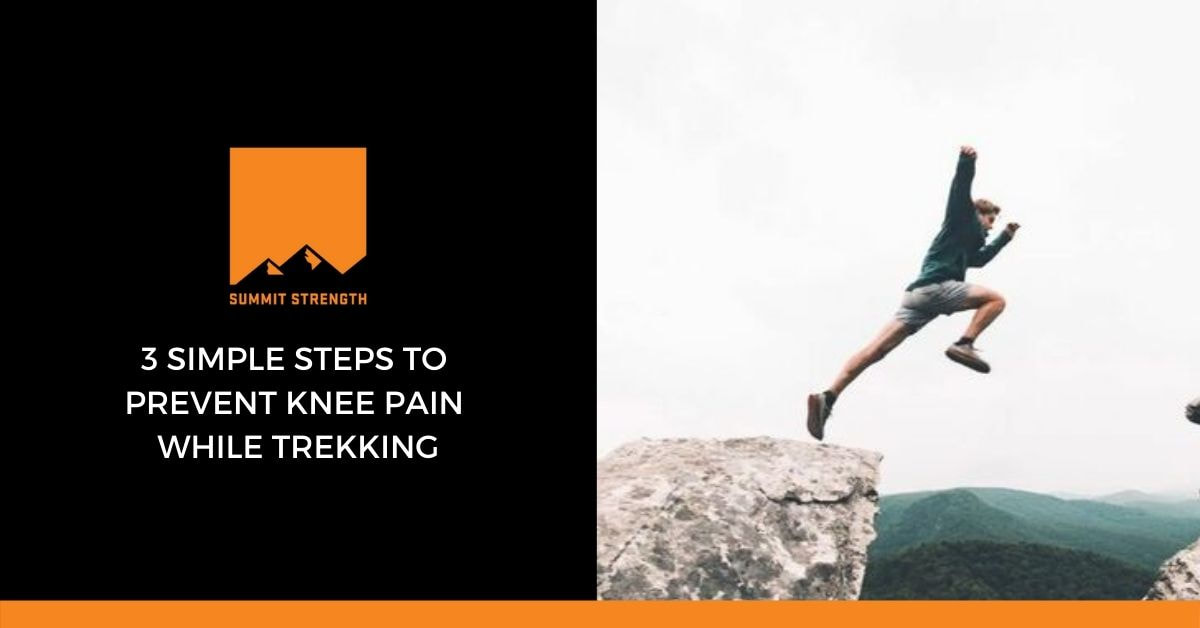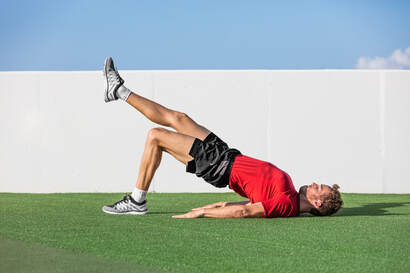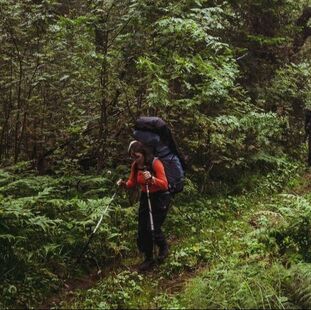|
Have you ever been hiking on a beautiful day, blue skies, birds are singing, when the knee pain has been so severe that it's spoiled your enjoyment of your time in nature? If so, you'll need a way to fix knee pain when hiking - and urgently. Knee pain while hiking is the worst... it is an easy way to turn a beautiful day out into an absolute nightmare. Unfortunately, for hikers and trekkers, it is an incredibly common issue. In fact, about 75% of hikers and trekkers I talk to on a daily basis report some type of knee pain while on the trail. Hiking knee pain isn't unique to hiking. It's commonly experienced among some runners and cyclists too. Hiking knee pain is frequently experienced as pain behind the knee cap itself. A diagnosis of this knee pain may be Chondromalacia, or sometimes Patellofemoral Stress Syndrome. If your knee pain is made worse when walking up or downstairs after a hike, hiking uphill, or involves the knee is straight and bearing weight, this could be the issue. What Is the Advice Out There for Hiker's Knee Pain? The issue is, the majority of the information you will find on the internet on this subject, just doesn't cut it. Advice like "use a knee brace", "tape up your knee" and "get some orthotics" are only band-aid solutions. Ignoring pain isn't a good strategy. It can likely lead to knee pain getting worse, or aggravating an existing injury. There are likely fundamental issues that should be addressed before slapping a knee brace on and trying to hike through the pain. The second you stop using them, the pain comes back straight away... and you are stuck in a never-ending loop. And while knee braces and strapping tape can help relieve pain temporarily, it's definitely not a long term strategy. Your knee pain is indicating something is wrong, and that shouldn't be overlooked. What Could Be the Root Cause? Quite often, the problem is that the hiker's knee is getting twisted during the hike - which could indicate a strength and mobility issue with the muscles in the feet, leg or hips. Other hikers may simply be putting in so many miles each week that they're inflaming the knee through overuse. So over the years, I have had to develop my solution to this problem. And I am going to share it with you today. (For a free 12 week training program to put all this information into action, follow the link at the bottom of the page) my 3 Step System for preventing hiker's knee (and enjoying pain free movement on the trail!)Once you know what is behind your knee pain, you can start exploring how to fix that knee pain so your hiking experience can be pure joy. Let's look at the steps you can take to address all possible areas. Step #1: Mobility Often an underlying cause of knee pain for hikers and trekkers is a lack of mobility in the muscles both above and below the knee. This is usually caused by a combination of the strains of modern living as well as the demands of whatever exercise you might be doing. The issue here is that for the knee to work best, it has to remain stable. However, if the joints both above and below the knee do not have enough movement, the body will compensate by allowing more movement through the knee joint. This is often a significant contributor to pain! Muscles that need to be mobilised:
Mobility work in these areas can be preventative if you're prone to knee pain. It may slow you down a little from getting out on to the trail, but knowing that your joints are adequately prepared for the hike before you set off can help limit the knee pain from hiking and can shorten your recovery time between hikes. *This is best done through a combination of regular foam rolling and stretching. Step #2: Stability Another issue is when the stabilising muscles of the knee are just not strong enough. When these muscles fatigue prematurely, the body won't be able to keep the knees secure. This again allows more movement in the knee joint, making it take a lot more strain then it should! These muscles need to be strengthened:
To fix knee pain long term, these muscles above and below the knee must be made strong enough to take the demands of a long hike. The role of the knee is to flex the muscles above them, so the stronger those muscles are, the longer and more challenging you can make your hike without experiencing any pain. *For a detailed training program to help with this (with video instructions included) follow the link at the bottom of the page. Step #3: Use Trekking PolesKnee pain from hiking is often made worse by going uphill and downhill. But you and I both know - that's where the best views are! So not going up hills is out of the question. Using trekking poles can do wonders for knee pain because they help promote stability and balance in the muscles around the knee. That means the knee cap itself is being asked to do much less work, and you'll feel less tired when the terrain is tricky or slippery. There is no excuse not to use trekking poles! Studies have shown they can reduce up to 30% of the force on the knee when going downhill. This is absolutely huge! Particularly for hikers that are reporting significant milage, or like to hike through challenging terrain which is hilly or ground coverage includes loose rocks or scree and the risk of slipping or twisting the knee is that much more significant. Not only this, but they can help improve movement efficiency while going uphill (reducing muscle fatigue) and increase your stability and balance (and reduce the risk of any slips, stumbles or falls adding to your pain) Buy some and sue them! A pair of trekking poles and some well-fitting lace-up boots can reduce the repetitive strain on your knees on a hike by a lot. This is particularly important if you enjoy hiking in remote places where knee inflammation could be not only painful but potentially dangerous as well. (If your not sure how to use trekking poles, check out this great article.) If you suffer from knee pain when hiking and you want to fix that pain for good, simply follow these 3 steps and I guarantee that you will soon be hiking with pain-free knees and be able to enjoy your adventures once again! 10/30/2019 09:57:23 pm
Thanks for sharing such good information with us!!! Keep doing good work.
Rowan Smith
11/4/2019 01:04:16 pm
Glad you are enjoying it! 12/2/2019 02:13:42 am
Thanks for sharing such a wonderful article with us. Since its a gift for the people who wanna know about this.
Rowan Smith
12/2/2019 08:50:31 pm
Absolutely my pleasure, so glad you enjoyed it!
Rowan
9/14/2020 04:30:30 pm
Glad you liked it! 9/18/2020 02:08:29 am
I would like to give you huge thumbs up for the information you have shared in this post.
Rowan
9/19/2020 05:44:11 pm
Great to hear you enjoyed it! 11/30/2020 11:55:06 pm
Wonderful content as always. I love how you talk about the projects and topics in detail. Keep the articles coming. Comments are closed.
|
AuthorRowan is a personal trainer who specialises in training for hiking, trekkers and mountaineers for their bucket list adventures. Archives
July 2024
Categories
All
|
AboutSummit Strength is a personal training for hiking service created specifically to help hikers have the best chance of a safe, enjoyable and successful adventure.
|
Company |
Services |
|
|
© COPYRIGHT 2018. ALL RIGHTS RESERVED.
|
Website Design by My Personal Trainer Website
|





 RSS Feed
RSS Feed
